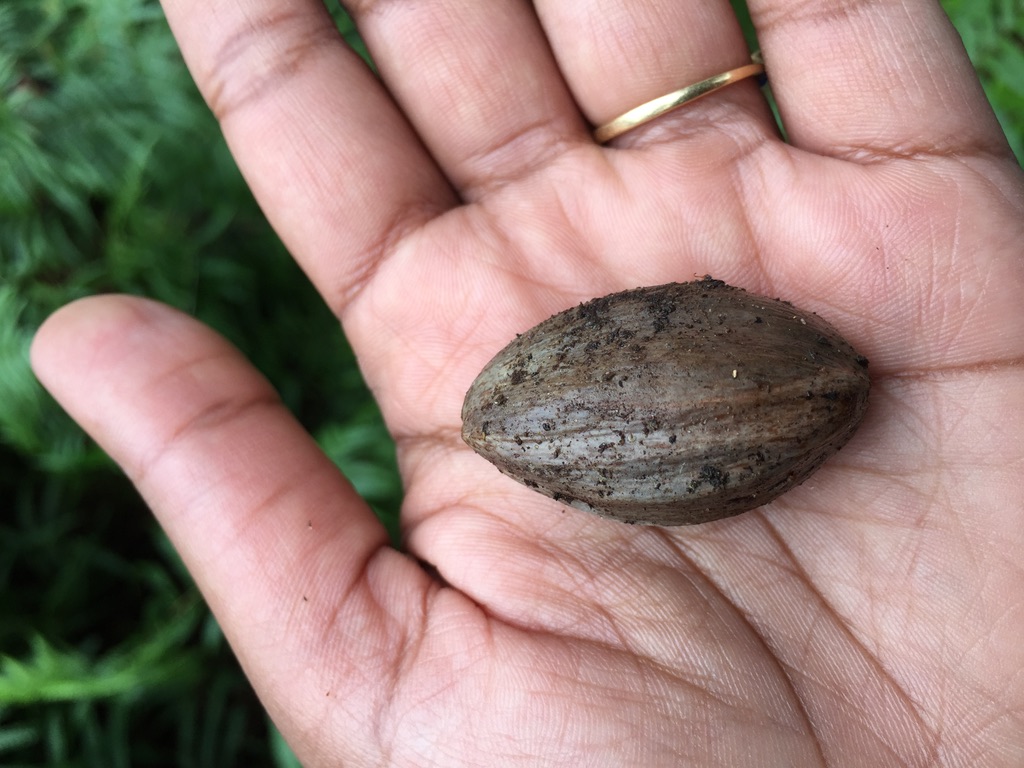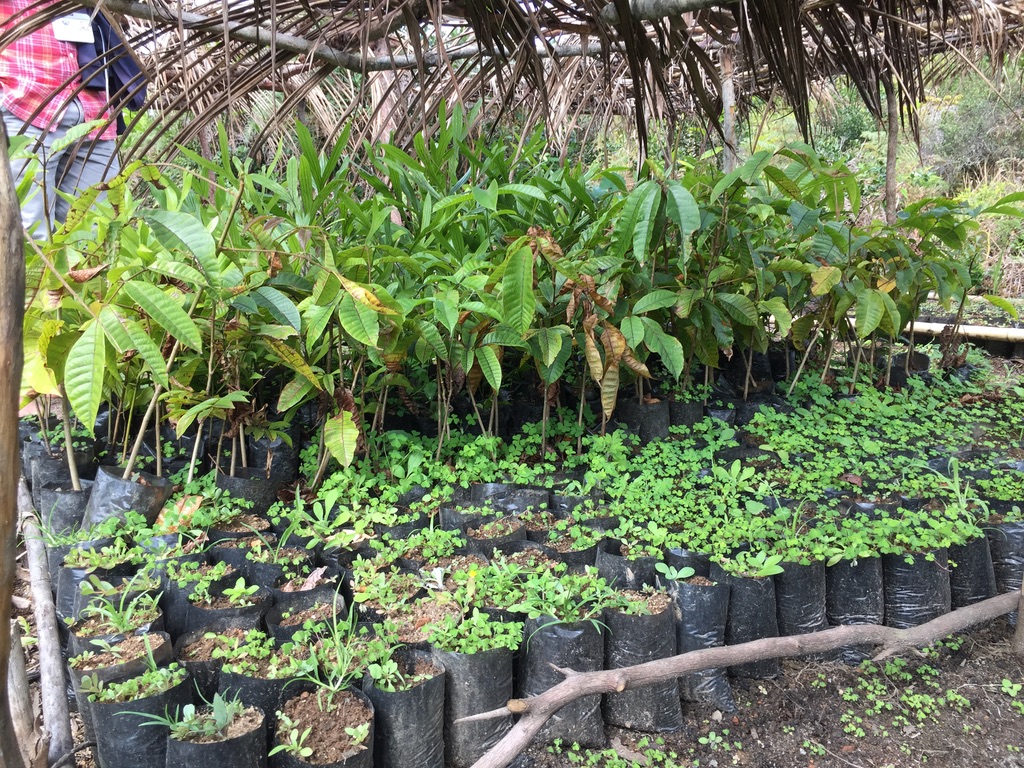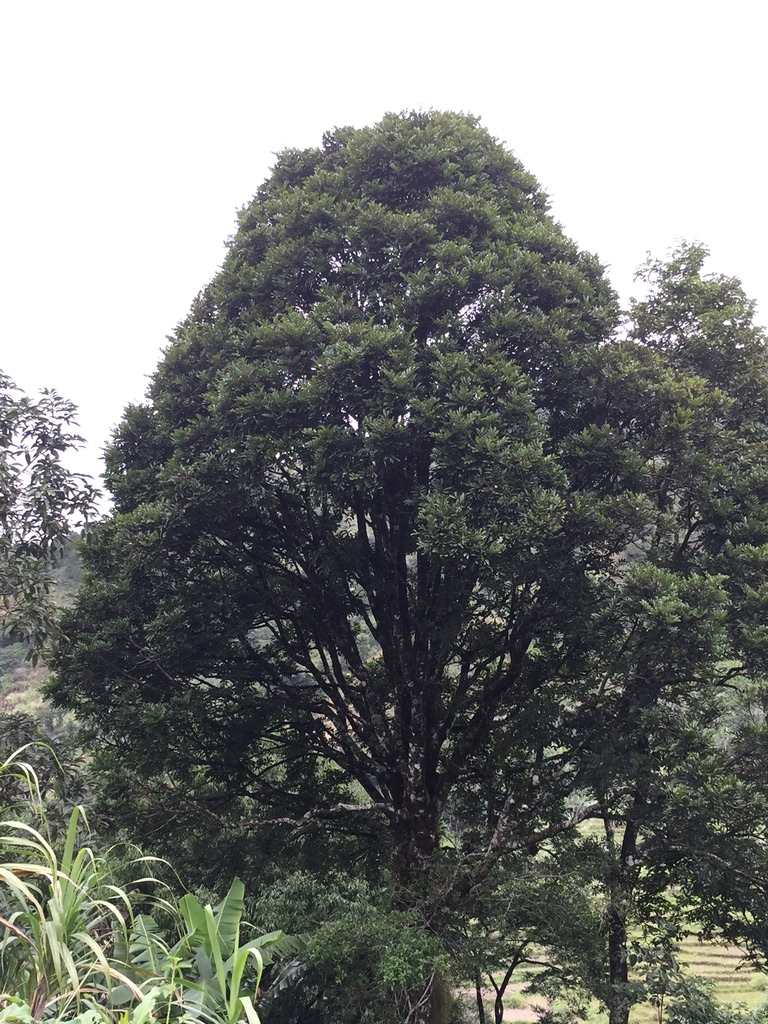- Madagascar’s president is pushing an ambitious plan to plant trees on 40,000 hectares (99,000 acres) of land every year for the next five years.
- But conservation experts point to shortcomings in the plan, including the use of disincentives and imposition of targets to compel NGOs and other organizations to get on board.
- There’s also the very real risk that in racing to meet the target, fast-growing non-native species will be prioritized, including acacia and pine, over slow-growing endemic species.
- Conservationists have called for a more collaborative approach to the replanting initiative to seek community buy-in and ensure the long-term effectiveness of the program.
RANOMAFANA and ANTANANARIVO, Madagascar — While many U.S. travelers dream of the fabled forests of Madagascar, for Malagasy conservationist Mahandry Hugues Andrianarisoa, 28, it was the verdant landscape of upstate New York that took his breath away.
“That is what I want for my country,” Andrianarisoa said on a July afternoon, eyeing a balding patch of woodland near Ranomafana National Park, one of the last refuges for Madagascar’s astonishing biodiversity.
His vision for a greener Madagascar appears to be shared by the country’s president, Andry Rajoelina, even if they don’t quite see greening the same way. About half of the country’s forests vanished between 1953 and 2014, much of it to make way for farmland and to produce charcoal, baring its rusty red earth and raising fears that the world’s oldest island could be stripped of all its natural forests within decades.
This March, Rajoelina declared that Madagascar will reforest at least 40,000 hectares (99,000 acres), an area about the size of Ranomafana, every year for the next five years. “If we called Madagascar the red island, now it will be the green island thanks to our national reforestation plan,” he said in March at the One Planet summit in Nairobi. To mark Madagascar’s 60th year of independence next year, the president announced in October that the country will plant 60 million seedlings in one day on January 19th.
But stakeholders say that the lofty ambition is not underpinned by a considered plan. To outpace the runaway deforestation, planting drives must beget forests. Instead, forest experts told Mongabay, there is a risk of the vast island, spanning 59 million hectares (146 million acres), being overrun by fast-growing invasive tree species like pine, eucalyptus and acacia that are planted to be harvested.

Rajoelina has launched a highly publicized campaign, but a top-down approach with a singular focus on meeting the 40,000-hectare goal will by itself not ensure the return of forests, the experts said. Yet the president, they recognized, is faced with the unenviable task of steering the Malagasy people onto a path of development not dependent on devouring wood while at the same time meeting their most pressing needs.
Racing to plant trees
Andrianarisoa, who hails from Kiranomena town in central Madagascar, has observed the destruction of forests firsthand. His grandparents, early settlers in the area, would narrate stories of lemurs that lived there, but these creatures remained almost mythical for him until he came to work at Ranomafana in the southeastern part of the country. The park hosts 13 lemur species, primates that are found only in Madagascar, and more than 370 plant species. On every return home Andrianarisoa saw the forests surrounding his hometown recede, a fate he hopes the moist evergreen forests of Ranomafana will escape.
Though the pace of forest loss across the country is uneven, following the president’s declaration the environment ministry asked all 22 regions, the second tier of administration in Madagascar, to reforest 2,000 hectares (4,900 acres) per year. Regions are relying on local governments, schools, NGOs and the private sector to meet their goal. When asked where the government intended to plant the trees, environment minister Alexandre Georget told Mongabay “everywhere” in July, suggesting that the plantings would happen on public as well as private lands. Although the minister said that these would all be endemic species, it appears that agroforestry projects and monoculture plantations using non-native and even invasive food and timber species are being included. The minister did not respond to recent attempts to clarify the government’s position.
What is evident is that the campaign is hurtling along at breakneck speed. Madagascar allocated about $684,000 in its budget for the drive this year and is actively seeking foreign aid. It is rounding up seeds on a war footing, distributing seedlings free of cost to people, and planning to bombard remote areas with seeds using drones and planes. By year-end, 85 percent of 2019’s 40,000-hectare target will be achieved, Georget told Mongabay in July.
Pushing for forests with sticks

To achieve their planting targets, regions are leaning heavily on NGOs that collect seeds, maintain nurseries and organize transplantation drives. One of these is the Centre ValBio (CVB) research station at Ranomafana National Park, where Andrianarisoa works. CVB helps Madagascar National Parks, a quasi-governmental agency, manage Ranomafana, a common arrangement for overseeing the country’s protected areas.
One of the sticks the government wields is linking permissions to reforestation targets. As part of the greening campaign, the environment ministry has asked NGOs that manage protected areas to reforest 1 percent of the area they manage every year or risk losing their management contracts. In his July interview with Mongabay, Georget suggested that government authorization for NGOs to accept foreign funding could hinge on their achieving their reforestation targets as well, though the government has not issued any directive to that effect.
“The president said we are going to do this, but there is no plan,” Nicolas Naina Rasolonjatovo, 31, who heads the reforestation program at CVB, told Mongabay. “We do not want a perfect plan, but we want something.” Other conservation-focused NGOs echoed the view that they are seeking a clear roadmap, not threats.
In the Mongabay interview, the environment minister alleged that NGOs are misusing their funds, and this has not helped matters. “Managing a protected area is itself challenging, and we don’t have enough resources for that,” said Nanie Ratsifandrihamanana, country director at WWF-Madagascar, which manages four protected areas. “The budget we have for reforestation we use it to train villagers, help them maintain nurseries and monitor plants.”
For the private sector, too, the government is making permissions contingent on meeting reforestation targets. Gaëtan Etancelin, president of Syndicat Malgache de l’Agriculture Biologique (SYMABIO), a trade group representing producers of organic products, told Mongabay that companies were struggling to meet their reforestation requirements. Etancelin said private players are looking for better incentives. “They don’t have time, it is not their job,” he said, referring to the reforestry efforts.
Companies that do have experience planting trees are looking to meet their requirements in ways that contribute to their business goals. A representative of Imperial Tobacco Madagascar, which participated in a recent reforestation event in northwest Madagascar, told Mongabay that the company’s planting target is determined by its demand for wood, which it burns to cure tobacco. The company, part of U.K.-headquartered Imperial Brands plc., already plants trees on its own land but will expand onto 100 hectares (247 acres) of land identified by the government in 2020 where it plans to plant both exotic and indigenous species. “Although it is challenging, it is a business requirement,” the representative said in an emailed response.

Trees: Slow-growing capital
Andrianarisoa attends to the young plants in his care with the watchfulness of a guardian. At Akopa, a reforestation site bordering Ranomafana, he pinpointed individual plants from a messy green spread, cautiously avoiding treading on saplings, including a ramy plant that barely reached his knee. Ramy refers to 33 tree species in the genus Canarium, all endemic to Madagascar.
Last year, CVB planted 26,000 saplings around the park as part of its long-standing reforestation program. The saplings spend about eight months at nurseries managed by CVB and local villagers before being transplanted to designated reforestation sites.
To reforest 40,000 hectares per year, the Rajoelina government estimates that 40 million saplings will have to be planted annually by 6 million people. Even those massive numbers might not be enough, though, so the government is looking at dropping seed balls from planes and drones. Nurturing and then transplanting seedlings from nurseries appears tedious in comparison, but evidence about the success of aerial reforestation is meager. At nurseries, bad seeds and weak seedlings are weeded out, ensuring higher odds of survival.

The CVB team knows from experience that tree planting involves more than just dropping seeds and watching beanstalks rise. The survival rate of plants, even from a nursery, can be as low as 40 percent. If it persists, the puny ramy sapling in Akopa could grow into a billowing deciduous tree reaching heights of 20 meters (66 feet), or three giraffes tall. To do so it must stand its ground in the face of natural calamities, humans and foraging animals, and compete with banana and pine trees that are sprouting all around. It will be at least two decades before it starts bearing fruit.
Once it does, the ramy tree could attract aye-aye lemurs (Daubentonia madagascariensis), the largest nocturnal primate in the world. It could, that is, if there are any left in the wild; aye-aye, whose diet includes insect larvae and ramy seeds, are one step away from being declared critically endangered by the International Union for Conservation of Nature and Natural Resources (IUCN).
One of the peculiarities of this elfin lemur is an elongated middle finger, with which it knocks rapidly on dead wood in search of cavities that hold insect larvae. If its flappy ears pick up a hollow, it gnaws an opening in the bark, inserts its long, skeletal third digit, and then impales and extracts its prey. Its sharp, rodent-like incisors also help bore into the fruit of the ramy tree to feed on its fleshy seed. However, in degraded forests in and around Ranomafana these trees are few and far between. The reforestation campaign could change this, but slow-growing ramy are not the trees of choice for villagers living around the park.

The fruits of reforestation
At a village-managed nursery in Tanambao village near Ranomafana, fledging ramy seedlings shared space with invasive acacia trees (Acacia mangium) that are native to Australia, New Guinea and Indonesia. “I don’t know why they are here,” Andrianarisoa said, concern sweeping his youthful face. “We did not ask them to plant these.”
He may have been concerned, but he was not entirely surprised. The nursery sits atop a knoll, with mud-and-wood houses scattered around, interspersed by muddy rice fields. Like more than three-quarters of the Malagasy population, villagers here don’t have access to electricity. Wood pervades life; it builds homes, warms hearths, cooks meals. Acacias grow quickly; in favorable conditions young ones can grow 5 meters (16 feet) every year, making them an ideal source of fuelwood and building material.
Clerizia Andre, 17, the daughter of the nursery owner, had never heard of the president’s reforestation campaign, but she was enthusiastic about planting trees. “From trees we get clean air, water, they help prevent erosion,” she said, “and they are used for building houses.” When asked which trees should be planted, she replied promptly: “Eucalyptus and pine trees.”

The aspiration for a green Madagascar is not new. The French, who colonized the country from 1896 until its independence in 1960, undertook a zealous tree-planting program that installed large plantations of fast-growing non-native species like eucalyptus and pine. Since independence, every year during the November-to-April rainy season, the country embarks on a tree-planting campaign launched in the capital, Antananarivo.
The Rajoelina government has tried to re-energize and scale up existing efforts, laying down targets for regions and districts and focusing on reporting, which hasn’t happened before. But the shadow of past planting drives hangs over the current campaign, according to Christian Kull, a professor with the Institute of Geography and Sustainability at the University of Lausanne in Switzerland, who has worked on forestry issues in Madagascar for more than 20 years.
“The reforestation drive in my opinion is problematic,” he said, explaining that regional and local government offices and NGOs implement tree-planting drives in ways that are “easy and familiar” to them. “What species do plant nurseries have available? What species do people have 100 years of experience how to plant? Eucalypts and acacias and pines,” he said.
“Even the ministry uses these [non-native] species; we have to explain the importance of endemic species to them,” said Andrianarisoa, who also organizes workshops for government officials. A ministry publication seen by Mongabay talks about how pinède restoration, using pine species, would be part of the reforestation effort. At a recent reforestation event in Mahajanga province in northwest Madagascar attended by the president, seeds from various trees species including Acacia mangium were on display.
Nurturing forests

To scale up reforestation efforts, plantings are happening on both public and private lands, but each comes with its own set of problems. On public lands, trees fare poorly without supervision, which is impractical, if not impossible, at the scale at which the Rajoelina government is planning reforestation. On private lands, people need incentives to plant trees that don’t immediately benefit them.
A pilot project launched by Seneca Park Zoo in upstate New York to monitor trees using satellites, GPS and blockchain technology brought Andrianarisoa to the U.S. in 2017. While he sees the value of technology to track trees, he acknowledged that people’s cooperation in securing trees is key to the success of any reforestation project. Money goes a long way in a country where about three-quarters of the population lives below the poverty line — something he can attest to because CVB regularly monitors the progress of its reforestation sites on both private and public lands. “What I see in the village is that once you have money to pay to take care of the trees, it works,” he said.
In Madagascar, NGOs use their own funds for reforestation, and appear unwilling to channel more resources into the government’s campaign without having a bigger say in it. Imposing targets is not the way, according to Rasolonjatovo at CVB. “First, discuss with the local community about where we will do the reforestation, why we do it there, and who owns the tree?” he said. “That is a good start.”
The collaborative approach has met with some success elsewhere. A recent report assessing progress made on the New York Declaration on Forests commended El Salvador for developing restoration and sustainable development plans with the help of local communities, the private sector, NGOs, small farmers, local governments, and indigenous peoples.
Tree survival is not the only concern. Such large-scale plantings alter landscapes and could have unintended consequences, like skewing the risk of forest fires. “If the reforestation drive were to focus on areas where forests used to grow, for example recently deforested areas in the east and west rather than in the fire-adapted open grasslands,” Kull said, “then the reforestation drive would make sense and be worthy of strong support.”
Not everybody sees the absence of a fleshed-out plan as a hurdle. “The details are still being worked out, but sometimes that is the way politics works and it is not necessarily a bad thing,” said Tim Christophersen, a senior U.N. Environment Programme official and chair of the Global Partnership on Forest and Landscape Restoration. “What is positive in Madagascar is that it is linked to the head of state which has a lot of advantages. One of them being that all the ministries who are involved need to pull in the same direction.”

The government is also supporting its reforestation campaign with efforts to reduce the country’s reliance on wood. During his March announcement Rajoelina said the government would provide a million cooking stoves each year for the next five years to reduce dependence on firewood. He has also pushed for a shift toward ethanol, a biofuel, in place of charcoal for cooking, and the government is developing a policy promoting renewable energy sources as part of a multi-sectoral effort called Initiative Emergence Madagascar.
“What it takes is three things: political will and leadership, good planning, and money,” Christophersen said of a successful reforestation campaign. “We should welcome this new enthusiasm [for planting trees] and help guide it in the right direction instead of saying: it is complicated leave it to the experts.”
At the time of publishing, the president’s office and Madagascar’s ministry of environment had not responded to requests for comments.
Editor’s note: Mongabay founder and CEO Rhett Butler is a member of Centre ValBio’s advisory board.
Malavika Vyawahare is the Madagascar staff writer for Mongabay. Find her on Twitter: @MalavikaVy
FEEDBACK: Use this form to send a message to the author of this post. If you want to post a public comment, you can do that at the bottom of the page.
(Editor’s note: The article has been updated to clarify that Madagascar will be hosting a large-scale planting drive on January 19, 2020 to mark 60 years of independence, not on its independence day in June.)